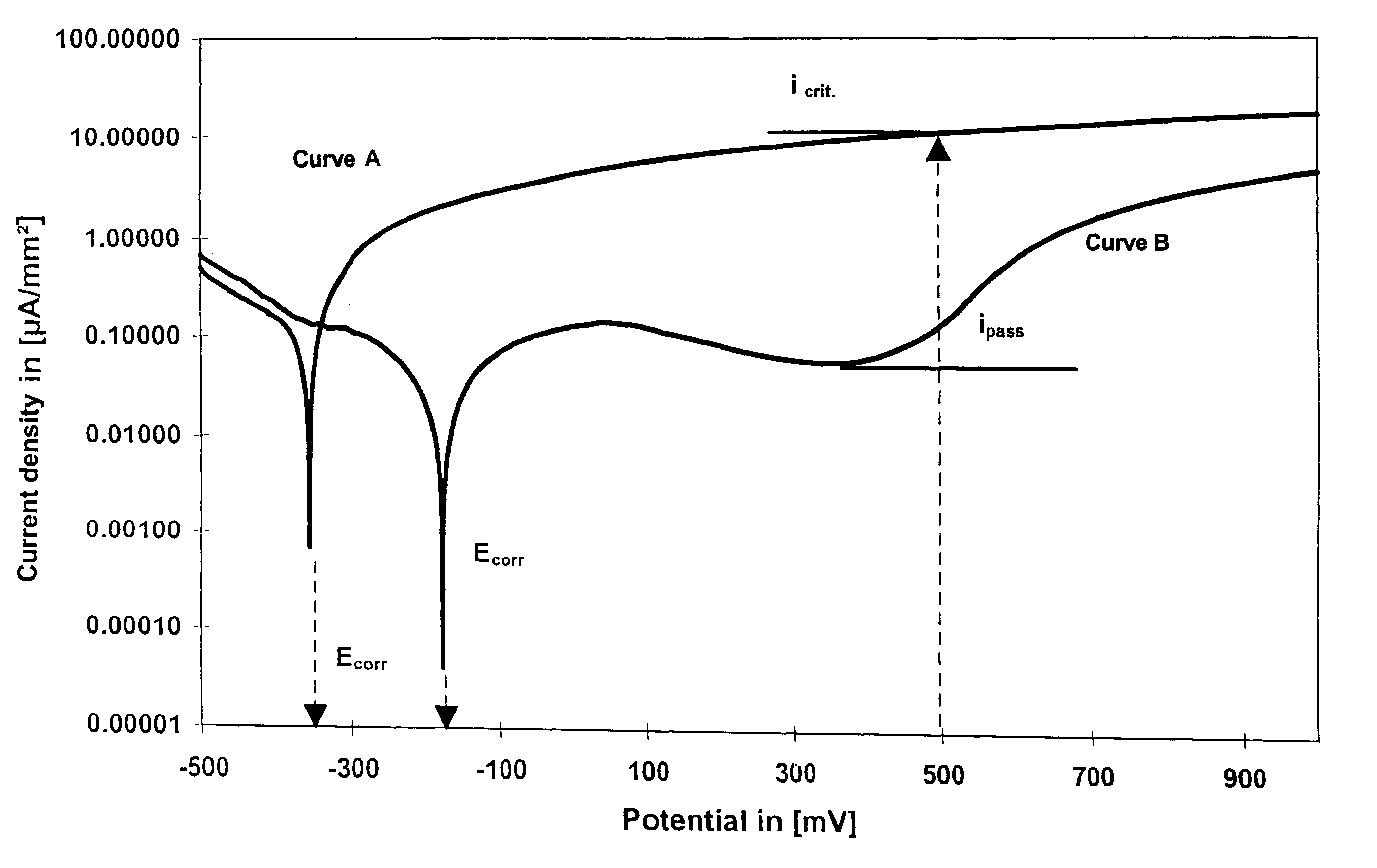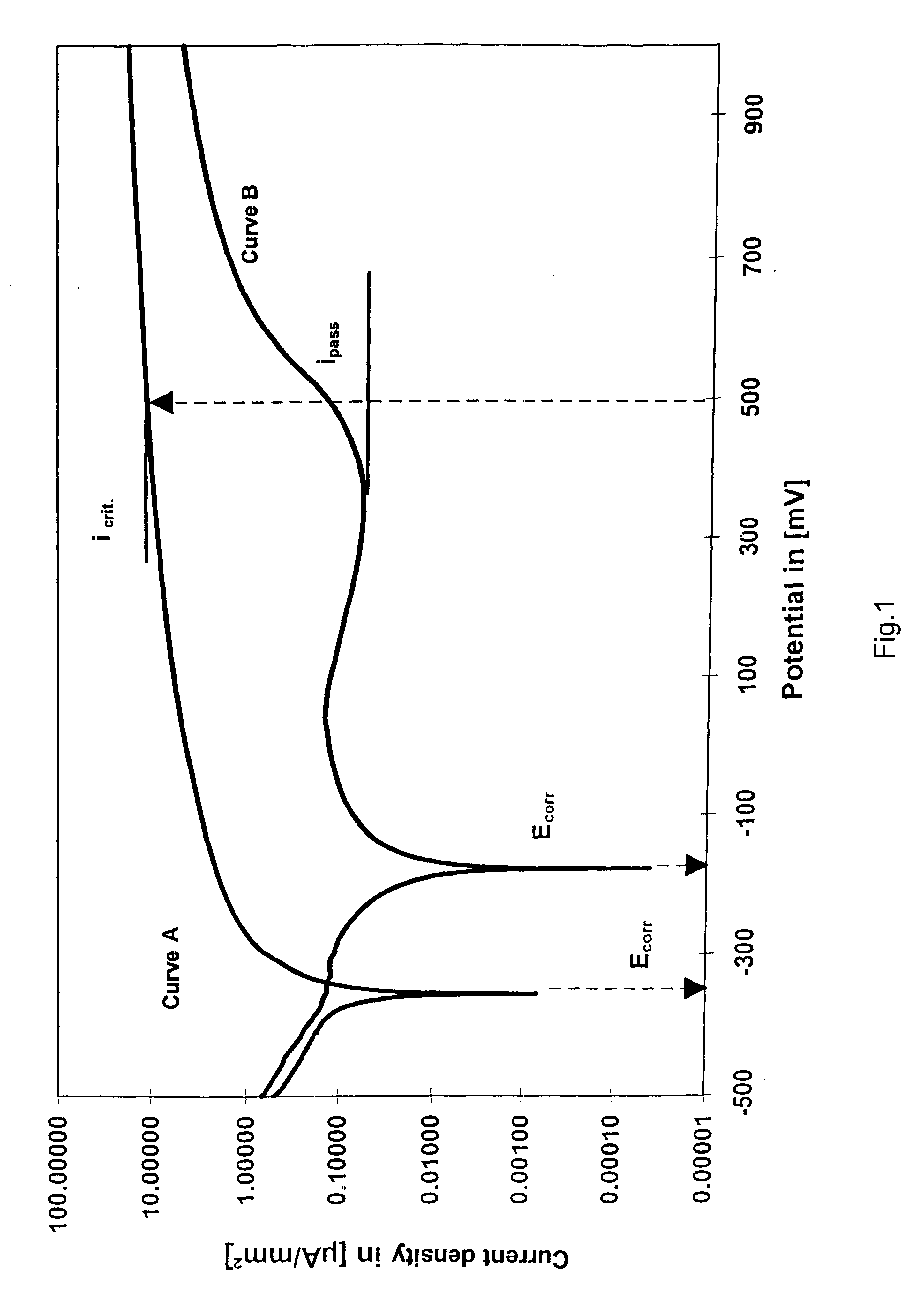Cutting metal alloy for shaping by electrical discharge machining methods
a technology of electrical discharge and metal alloy, applied in the field of cutting metal alloy, can solve the problems of limited application of cobalt-rhenium binder, lower hardness, and lower toughness of abrasives,
- Summary
- Abstract
- Description
- Claims
- Application Information
AI Technical Summary
Benefits of technology
Problems solved by technology
Method used
Image
Examples
example 2
The powder batch had the following composition in accordance with the invention: 12 wt % Co; 0.1 wt % Ge; 0.2 wt % TiC; 0.4 [wt %] Ta / NbC; remainder WC.
The production process for the fabrication of the cutting metal sample and the physical-mechanical characteristics determined on the sample corresponded to those of Example 1 and at the same time, to those of the ISO type K40. The electrochemical corrosion studies were carried out as described before Example 1.
The following values were produced:
Curve type: "A"
E.sub.corr (mV)=-288
i.sub.crit (.mu.A / mm.sup.2)=8.021
A comparison with the standard type K40 showed that the cutting metal according to this example also exhibited clearly more favorable corrosion values and notwithstanding, produced comparably good cutting results and service lives for punching tools produced by means of electrical discharge machining methods.
example 3
Example 3 was used for the determination of E.sub.corr, I.sub.pass characteristics for a cutting metal type which differs from the sta ndard K40 in that chromium was added to it, which suddenly makes this cutting metal alloy more corrosion-resistant, in comparison to a pure K40.
The powder composition used was, accordingly, the following: 12 wt % Co, 0.8 wt % Cr.sub.3 C.sub.2, remainder WC.
The characteristics thus obtained were used as a reference for Examples 4-7 below, in accordance with the invention, in which components essential to the invention were also added to a powder batch analogous to this Example 3.
By means of a microprobe measurement, it was determined that the Cr.sub.3 C.sub.2 added to the powder batch had decomposed during the sintering and that the Cr fractions were completely dissolved in the Co binding phase.
The electrochemical investigations corresponded to the description given above and produced the following:
Curve type: "B"
E.sub.corr (mV)=-247
i.sub.pass (.mu.A / ...
example 4
The powder selection and cutting metal production were carried out as described before Example 1; the chemical composition of the powder batch was as follows: 12% Co; 0.8% Cr.sub.3 C.sub.2 ; 500 wt-ppm Re; remainder WC.
The physical and mechanical characteristics agreed with those according to Example 1.
With the electrochemical current density potential measurement (carried out as described before Example 1), the following results were obtained:
Curve type B
E.sub.corr (mV)=-196.7
i.sub.pass (.mu.A / mm.sup.2)=0.0461
The addition of Re to an otherwise standard powder batch according to Example 3 brought about a sudden improvement in the coefficients E.sub.corr and i.sub.pass, in comparison to the values determined there.
From two sintered cutting metal blocks (dimensions: 150.times.80.times.45 mm), 40 punching rams for a rotor-stator tool were produced to finished dimensions, without any signs of a corrosive attack--under standard conditions specified by the unit manufacturer for an "AGIE E...
PUM
| Property | Measurement | Unit |
|---|---|---|
| diameter | aaaaa | aaaaa |
| grain size | aaaaa | aaaaa |
| depth | aaaaa | aaaaa |
Abstract
Description
Claims
Application Information
 Login to View More
Login to View More - R&D
- Intellectual Property
- Life Sciences
- Materials
- Tech Scout
- Unparalleled Data Quality
- Higher Quality Content
- 60% Fewer Hallucinations
Browse by: Latest US Patents, China's latest patents, Technical Efficacy Thesaurus, Application Domain, Technology Topic, Popular Technical Reports.
© 2025 PatSnap. All rights reserved.Legal|Privacy policy|Modern Slavery Act Transparency Statement|Sitemap|About US| Contact US: help@patsnap.com


